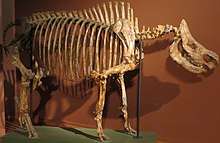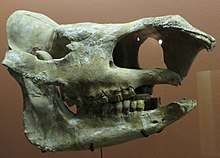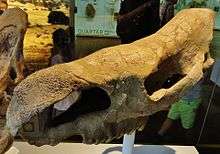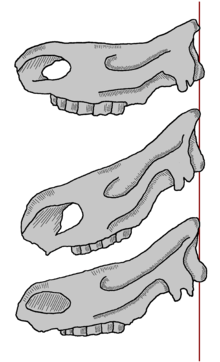Stephanorhinus
Stephanorhinus is an extinct genus of two-horned rhinoceros native to northern Eurasia and possibly North Africa that lived during the Pliocene to Late Pleistocene. Species of Stephanorhinus were the predominant and often only species of rhinoceros in much of temperate Eurasia, especially Europe, for most the Pleistocene. Two species of Stephanorhinus, Merck's rhinoceros S. kirchbergensis and the narrow-nosed rhinoceros S. hemitoechus persisted into the last glacial period, with the last record for the latter being around 40,000 years ago in Bacho Kiro cave in Bulgaria.[1]
| Stephanorhinus | |
|---|---|
 | |
| Stephanorhinus etruscus skeleton | |
_(16144915223).jpg) | |
| Stephanorhinus hundsheimensis skeleton | |
| Scientific classification | |
| Kingdom: | Animalia |
| Phylum: | Chordata |
| Class: | Mammalia |
| Order: | Perissodactyla |
| Family: | Rhinocerotidae |
| Tribe: | Dicerorhinini |
| Genus: | †Stephanorhinus Kretzoi, 1942 |
| Species | |
| |
Etymology
The first part of the name is derived from that of King Stephen I of Hungary,[2] and the second part from 'rhinos' (ρινος, meaning "nose"), as with Dicerorhinus.
Taxonomy
The taxonomic history of Stephanorhinus is long and convoluted, as many species are known by numerous synonyms and different genera, typically Rhinoceros and Dicerorhinus for the 19th and most of the early 20th century. The genus was named by Miklós Kretzoi in 1942.[3] It is thought that Stephanorhinus is more closely related to the Sumatran rhinoceros and woolly rhinoceros than other rhino species. A complete mitochondrial genome of S. kirchbergensis obtained from a 70,000 - 48,000 year old skull preserved in permafrost in arctic Yakutia showed that it was more closely related to the woolly rhinoceros than the Sumatran rhinoceros.[4] In 2019 a study of dental proteomes showed that the genus was paraphyletic as currently defined, as the genus Coelodonta was found to be derived from an early diverging lineage within Stephanorhinus, with the proteome sequence obtained from the enamel of a 1.77 million year old Stephanorhinus sp. tooth from Dmanisi outside the clade containing the woolly rhinoceros and S. kirchbergensis.[5]
Species and evolution
The oldest known species of the genus are from the Pliocene of Europe, the species S. pikermiensis and S. megarhinus that were formerly considered to belong to Stephanorhinus are currently considered to belong to Dihoplus,[6] while the positions of “Stephanorhinus” miguelcrusafonti from the Early Pliocene of Western Europe and Stephanorhinus? africanus from the Middle Pliocene of Tunisia and Chad are uncertain.[7]

Stephanorhinus jeanvireti, also known as S. elatus[8] is known from the Late Pliocene and Early Pleistocene of Europe. Its remains are relatively rare in comparison to other Stephanorhinus species. Specimens are known from the Late Pliocene of Germany[9] France, Italy,[10] Slovakia[11] and Greece,[12] and the Early Pleistocene of Romania.[13]
Stephanorhinus etruscus first appears in the latest Pliocene in the Iberian Peninsula, around 3.3 Ma at Las Higueruelas in Spain and before 3 Ma at Piedrabuena, and during the latest Pliocene at Villafranca d’Asti and Castelnuovo di Barardenga in Italy and is abundant during most of the Villafranchian period in Europe, and is the sole rhinoceros species in Europe between 2.5 to around 1.3 Ma. A specimen is known from the Early Pleistocene (1.6-1.2 Ma) Ubeidiya locality in Israel. During the late Early Pleistocene it is largely replaced by S. hundsheimensis. The last known records of the species are from the latest Early Pleistocene of the Iberian peninsula, around 0.9-0.8 Ma.[14]
Stephanorhinus yunchuchenensis is known from a single specimen in Early Pleistocene deposits in Yushe County, Shaanxi while Stephanorhinus lantianensis is also known from a single specimen from late Early Pleistocene (1.15 Ma) deposits in Lantian County, Shaanxi.[15] These are stated to be synonyms of Stephanorhinus kirchbergensis by some sources.[16]
The first record of Stephanorhinus kirchbergensis is in China at Choukoutien Locality 13, in Fangshan District near Beijing which is around the Early-Mid Pleistocene transition at 0.8 Ma.[15]

Stephanorhinus hundsheimensis first defintively appears in the fossil record in Europe and Anatolia at around 1.2 Ma, with possible records in Iberia around 1.6 Ma and 1.4-1.3 Ma. The earliest confirmed appearance in Italy around 1 Ma.[17] The diet of S. hundsheimensis was flexible and ungeneralised, with two different early Middle Pleistocene populations under different climactic regimes having tooth wear analyses suggesting contrasting browsing and grazing habits.[18] The more specialised S. kirchbergensis and S. hemiotoechus,, appear in Europe between 0.7-6 Ma and 0.6-0.5 Ma respectively, and replace S. hundsheimensis. S. kirchbergensis and S. hemiotoechus are typically interpreted as a browsing form and grazing form, respectively. The evolution of more specialized diets is possibly due to the change to the 100 Kyr cycle after the Mid Pleistocene Transition, which resulted in environmental stability allowing the development of more specialized forms.[19]

From the late Middle Pleistocene onwards, the large Merck's rhinoceros (Stephanorhinus kirchbergensis) and the narrow-nosed rhinoceros (Stephanorhinus hemitoechus) were the only species of Stephanorhinus. S. kirchbergensis was broadly distributed over northern Eurasia, while S. hemitoechus was generally confined to the western Palearctic.[20] S. kirchbergensis is relatively rare in fossil record and known from few Italian, French, German, British, and East-European localities, mostly of the middle Pleistocene. In Asia it is known from Siberia, Central Asia (e.g. southeastern Kazakhstan), Central Korea, and China. It may have also occurred in Israel and Lebanon, but here it is unclear if it was really S. kirchbergensis or a similar species.[21] In eastern China, S. kirchbergensis was present throughout the Pleistocene between 30°N and 40°N.[16] It is stated by some sources that S. hemitoechus occurs in North Africa.[7]
In eastern Europe S. kirchbergensis disappeared during the earliest Late Pleistocene, where it is recorded in the Eemian in Poland. In the forests of the Caucasus it may have survived even until the early Weichselian. Apart from Europe it is also known from Syria, Israel, the Caucasus and from one Late Pleistocene locality close to Lake Baikal. This is the easternmost point of the known range. The latest fossils of the narrow-nosed rhinoceros are known from the Balkans, where it survived until the early late Weichselian.[20] The last records of S. hemitoechus in Italy date to around 41 kya.[22] Remains of S. kirchbergensis in the Russian Far East and South China are suggested to date to MIS 3 and 2, respectively.[23][24]
References
- Stuart, A.J., Lister, A.M., 2007. Patterns of Late Quaternary megafaunal extinctions in Europe and northern Asia. In: Kahlke, R.-D., Maul, L.C., Mazza, P. (Eds.), Late Neogene and Quaternary Biodiversity and Evolution: Regional Developments and Interregional Correlations Vol. II, Proceedings of the 18th International Senckenberg Conference (VI International Palaeontological Colloquium in Weimar). Courier Forschungsinstitut Senckenberg 259, pp. 287-297.
- Tong, HaoWen; Wu, XianZhu (April 2010). "Stephanorhinus kirchbergensis (Rhinocerotidae, Mammalia) from the Rhino Cave in Shennongjia, Hubei". Chinese Science Bulletin. 55 (12): 1157–1168. Bibcode:2010ChSBu..55.1157T. doi:10.1007/s11434-010-0050-5. ISSN 1001-6538.
- Miklós Kretzoi: Bemerkungen zur System der Nachmiozänen Nashorn-Gattungen (Comments on the system of the post Miocene rhinoceros genera) Földtani Közlöni, Budapest 72 (4-12), 1942, S. 309–318
- Kirillova, Irina V.; Chernova, Olga F.; van der Made, Jan; Kukarskih, Vladimir V.; Shapiro, Beth; van der Plicht, Johannes; Shidlovskiy, Fedor K.; Heintzman, Peter D.; van Kolfschoten, Thijs; Zanina, Oksana G. (November 2017). "Discovery of the skull of Stephanorhinus kirchbergensis (Jäger, 1839) above the Arctic Circle". Quaternary Research. 88 (3): 537–550. Bibcode:2017QuRes..88..537K. doi:10.1017/qua.2017.53. ISSN 0033-5894.
- Cappellini, Enrico; Welker, Frido; Pandolfi, Luca; Ramos-Madrigal, Jazmín; Samodova, Diana; Rüther, Patrick L.; Fotakis, Anna K.; Lyon, David; Moreno-Mayar, J. Víctor; Bukhsianidze, Maia; et al. (October 2019). "Early Pleistocene enamel proteome from Dmanisi resolves Stephanorhinus phylogeny". Nature. 574 (7776): 103–107. Bibcode:2019Natur.574..103C. doi:10.1038/s41586-019-1555-y. ISSN 0028-0836. PMC 6894936. PMID 31511700.
- Pandolfi, Luca; Rivals, Florent; Rabinovich, Rivka (January 2020). "A new species of rhinoceros from the site of Bethlehem: 'Dihoplus' bethlehemsis sp. nov. (Mammalia, Rhinocerotidae)". Quaternary International. 537: 48–60. Bibcode:2020QuInt.537...48P. doi:10.1016/j.quaint.2020.01.011.
- Pandolfi, Luca (2018), "Evolutionary history of Rhinocerotina (Mammalia, Perissodactyla)", Fossilia - Reports in Palaeontology, Saverio Bartolini Lucenti, pp. 27–32, doi:10.32774/fosreppal.20.1810.102732, ISBN 979-12-200-3408-1
- Ballatore, Manuel; Breda, Marzia (December 2016). "Stephanorhinus elatus (Rhinocerotidae, Mammalia): proposal for the conservation of the earlier specific name and designation of a lectotype". Geodiversitas. 38 (4): 579–594. doi:10.5252/g2016n4a7. ISSN 1280-9659.
- Lacombat, Frédéric; Mörs, Thomas (2008-08-01). "The northernmost occurrence of the rare Late Pliocene rhinoceros Stephanorhinus jeanvireti (Mammalia, Perissodactyla)". Neues Jahrbuch für Geologie und Paläontologie - Abhandlungen. 249 (2): 157–165. doi:10.1127/0077-7749/2008/0249-0157.
- Pandolfi, Luca (October 2013). "New and revised occurrences of Dihoplus megarhinus (Mammalia, Rhinocerotidae) in the Pliocene of Italy". Swiss Journal of Palaeontology. 132 (2): 239–255. doi:10.1007/s13358-013-0056-0. ISSN 1664-2376.
- Šujan, M., Rybár, S., Šarinová, K., Kováč, M., Vlačiky, M., Zervanová, J., 2013. Uppermost Miocene to Quaternary accumulation history at the Danube Basin eastern flanks, in: Fodor, L., Kövér, Sz. (eds.), 11th Meeting of the Central European Tectonic Studies Group (CETeG). Abstract book, Geol. Geophys. Inst. of Hungary, Budapest, pp. 66-68.
- Guérin, Claude; Tsoukala, Evangelia (June 2013). "The Tapiridae, Rhinocerotidae and Suidae (Mammalia) of the Early Villafranchian site of Milia (Grevena, Macedonia, Greece)". Geodiversitas. 35 (2): 447–489. doi:10.5252/g2013n2a7. ISSN 1280-9659.
- Pandolfi, Luca; Codrea, Vlad A.; Popescu, Aurelian (December 2019). "Stephanorhinus jeanvireti (Mammalia, Rhinocerotidae) from the early Pleistocene of Colțești (southwestern Romania)". Comptes Rendus Palevol. 18 (8): 1041–1056. doi:10.1016/j.crpv.2019.07.004.
- Pandolfi, Luca; Cerdeño, Esperanza; Codrea, Vlad; Kotsakis, Tassos (September 2017). "Biogeography and chronology of the Eurasian extinct rhinoceros Stephanorhinus etruscus (Mammalia, Rhinocerotidae)". Comptes Rendus Palevol. 16 (7): 762–773. doi:10.1016/j.crpv.2017.06.004.
- Tong, Hao-wen (November 2012). "Evolution of the non-Coelodonta dicerorhine lineage in China". Comptes Rendus Palevol. 11 (8): 555–562. doi:10.1016/j.crpv.2012.06.002.
- Pierre Olivier Antoine: Pleistocene and holocene rhinocerotids (Mammalia, Perissodactyla) from the Indochinese Peninsula. In: Comptes Rendus Palevol. 2011, S. 1–10.
- Pandolfi, Luca; Erten, Hüseyin (January 2017). "Stephanorhinus hundsheimensis (Mammalia, Rhinocerotidae) from the late early Pleistocene deposits of the Denizli Basin (Anatolia, Turkey)". Geobios. 50 (1): 65–73. doi:10.1016/j.geobios.2016.10.002.
- Kahlke, Ralf-Dietrich; Kaiser, Thomas M. (August 2011). "Generalism as a subsistence strategy: advantages and limitations of the highly flexible feeding traits of Pleistocene Stephanorhinus hundsheimensis (Rhinocerotidae, Mammalia)". Quaternary Science Reviews. 30 (17–18): 2250–2261. Bibcode:2011QSRv...30.2250K. doi:10.1016/j.quascirev.2009.12.012.
- van Asperen, Eline N.; Kahlke, Ralf-Dietrich (January 2015). "Dietary variation and overlap in Central and Northwest European Stephanorhinus kirchbergensis and S. hemitoechus (Rhinocerotidae, Mammalia) influenced by habitat diversity". Quaternary Science Reviews. 107: 47–61. doi:10.1016/j.quascirev.2014.10.001.
- Diana Pushkina: The Pleistocene easternmost distribution in Eurasia of the species associated with the Eemian Palaeoloxodon antiquus assemblage. Mammal Review, 2007. Volume 37 Issue 3, Pages 224 - 245
- Emmanuel M.E. Billia: Revision of the fossil material attributed to Stephanorhinus kirchbergensis (Jäger 1839) (Mammalia, Rhinocerotidae) preserved in the museum collections of the Russian Federation. Quaternary International. Volume 179, Issue 1, March 2008, Pages 25-37
- PANDOLFI, LUCA; BOSCATO, PAOLO; CREZZINI, JACOPO; GATTA, MAURIZIO; MORONI, ADRIANA; ROLFO, MARIO; TAGLIACOZZO, ANTONIO (2017-04-13). "LATE PLEISTOCENE LAST OCCURRENCES OF THE NARROW-NOSED RHINOCEROS STEPHANORHINUS HEMITOECHUS (MAMMALIA, PERISSODACTYLA) IN ITALY". Rivista Italiana di Paleontologia e Stratigrafia (Research In Paleontology and Stratigraphy). V. 123: N. 2 (2017). doi:10.13130/2039-4942/8300.
- Kosintsev, P. A.; Zykov, S. V.; Tiunov, M. P.; Shpansky, A. V.; Gasilin, V. V.; Gimranov, D. O.; Devjashin, M. M. (March 2020). "The First Find of Merck's Rhinoceros (Mammalia, Perissodactyla, Rhinocerotidae, Stephanorhinus kirchbergensis Jäger, 1839) Remains in the Russian Far East". Doklady Biological Sciences. 491 (1): 47–49. doi:10.1134/S0012496620010032. ISSN 0012-4966.
- Pang, Libo; Chen, Shaokun; Huang, Wanbo; Wu, Yan; Wei, Guangbiao (April 2017). "Paleoenvironmental and chronological analysis of the mammalian fauna from Migong Cave in the Three Gorges Area, China". Quaternary International. 434: 25–31. doi:10.1016/j.quaint.2014.11.039.